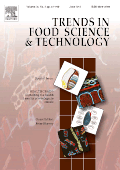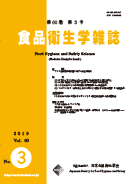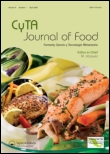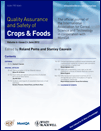
Journal of Consumer Protection and Food Safety
Scope & Guideline
Pioneering insights for responsible food production.
Introduction
Aims and Scopes
- Food Safety Analysis:
This journal emphasizes rigorous analytical methods for assessing food safety, including detection of contaminants, pathogens, and residues in food products. The methodologies range from molecular techniques like PCR to traditional microbiological assessments. - Consumer Behavior and Perception:
Research on consumer attitudes towards food safety, labeling, and quality assurance is a core focus. This includes studies on how consumers interact with information at the point of sale and their willingness to pay for higher safety standards. - Regulatory and Policy Frameworks:
The journal explores the implications of food safety regulations and policies on public health and consumer protection, including evaluations of current practices and recommendations for improvements. - Sustainable Practices in Food Production:
There is a strong emphasis on sustainability, including studies on organic farming, animal welfare, and the environmental impacts of food production processes. - Technological Innovations in Food Safety:
The journal highlights advancements in technology that enhance food safety, such as digital traceability systems and novel packaging solutions.
Trending and Emerging
- Digital Food Safety Solutions:
There is a marked increase in research focused on digital traceability and data management systems in food safety, reflecting the industry's move towards technology-driven solutions to enhance transparency and consumer trust. - Consumer Health and Safety in the Context of Pandemics:
The COVID-19 pandemic has heightened awareness around food safety and health, leading to a surge in studies examining consumer behavior and safety practices in light of health crises. - Sustainability and Ethical Consumption:
Emerging themes related to sustainable practices in food production and ethical consumption are increasingly prevalent, as consumers demand more transparency regarding the environmental and social impacts of their food choices. - Regulatory Innovations and Risk Assessment:
There is growing interest in innovative regulatory approaches and methodologies for risk assessment, particularly in the context of new food products and technologies. - Consumer Education and Engagement:
Research is increasingly focusing on strategies to educate consumers about food safety practices and empower them to make informed choices, reflecting a shift towards consumer engagement in food safety discussions.
Declining or Waning
- Traditional Food Processing Techniques:
Research related to conventional food processing methods is becoming less prevalent, as there is a shift towards innovative and technology-driven solutions that promise better food safety outcomes. - General Food Quality Studies:
There appears to be a decline in generic studies on food quality that do not specifically address safety concerns or consumer perceptions, as the journal increasingly prioritizes targeted research with clear implications for consumer protection. - Focus on Imported Food Safety Issues:
Papers discussing imported food safety issues have decreased, possibly due to a growing emphasis on local food systems and the implications of global supply chains on food safety.
Similar Journals

TRENDS IN FOOD SCIENCE & TECHNOLOGY
Exploring the forefront of food science and technology.Trends in Food Science & Technology, published by Elsevier Science London, stands as a premier journal in the fields of food science and biotechnology. With an impressive Q1 ranking in both the food science and biotechnology categories, it is recognized for its rigorous peer-reviewed articles that advance knowledge and innovation in the sector. The journal’s Scopus rankings validate its significance, placing it in the top percentile among its peers, with a remarkable rank of #2 out of 389 in Agricultural and Biological Sciences - Food Science, and #4 out of 311 in Biochemistry, Genetics, and Molecular Biology - Biotechnology. Since its inception in 1990, the journal has become a vital resource for researchers, professionals, and students alike, offering insights into contemporary challenges and trends impacting food technology. Although it operates under a subscription model, the quality of research published within its pages makes it an essential read for anyone involved in advancing the science of food.

Food Analytical Methods
Unveiling the science behind food quality and safety.Food Analytical Methods, published by Springer, is an esteemed journal dedicated to the innovative field of analytical methodologies within the food sciences. With an ISSN of 1936-9751 and E-ISSN of 1936-976X, this journal serves as a pivotal platform for researchers and professionals to exchange insights, methodologies, and findings related to food quality analysis, safety measures, and innovative technologies in food science. As of 2023, Food Analytical Methods boasts impressive Scopus rankings, including Q2 in Analytical Chemistry and Food Science, positioning it among the top journals in its category. The journal's commitment to enhancing food safety and quality through rigorous research underscores its importance in both academic and industrial applications. Although it does not currently operate under an open-access model, it provides exceptional value through its rigorous peer-review process and comprehensive publication standards, further inviting contributions from both established and emerging scientists in the field. With coverage spanning from 2008 to 2024, this journal continues to address critical research areas, thereby shaping the future of food analytics.

Food Hygiene and Safety Science
Empowering Knowledge to Enhance Food SafetyFood Hygiene and Safety Science is a pivotal academic journal published in Japan by the esteemed FOOD HYGIENE & SAFETY. With its ISSN 0015-6426, this journal operates within the broad domains of food science, public health, and medicine, strategically addressing the critical issues surrounding food hygiene and safety. With a notable history spanning from 1960 to 2024, it has become an essential resource in these fields, currently holding a Q3 category ranking in Food Science as well as in Medicine (Miscellaneous) and Public Health, Environmental and Occupational Health, according to the 2023 evaluations. Although access options may vary, the journal is committed to disseminating vital research findings to enhance food safety practices on a global scale. With its focus on advancing knowledge and sharing innovative practices, Food Hygiene and Safety Science serves as a vital platform for researchers, professionals, and students dedicated to improving food safety standards and public health outcomes.

Food Quality and Safety
Transforming food safety through rigorous scholarship.Food Quality and Safety is a leading academic journal published by Oxford University Press, dedicated to advancing research in the critical field of food science. With an ISSN of 2399-1399 and an E-ISSN of 2399-1402, the journal has gained prestigious recognition, securing a Q1 ranking in the Food Science category as per Scopus rankings, and being positioned at #69 out of 389 in its field, reflecting its influence and reputation within the discipline. Since its transition to Open Access in 2017, the journal has broadened its reach, ensuring that cutting-edge research related to food quality, safety measures, and consumer protection is accessible to researchers, professionals, and students alike. With a commitment to publishing high-quality articles and reviews, the journal addresses contemporary challenges in the food industry and promotes a better understanding of food safety protocols. Based in Oxford, United Kingdom, Food Quality and Safety plays a pivotal role in shaping future research and practices in food science, making it an essential platform for scholars who aim to impact the industry through innovative findings and applied research.

FOOD REVIEWS INTERNATIONAL
Bridging Academia and Industry in Food ScienceFOOD REVIEWS INTERNATIONAL, published by Taylor & Francis Inc, serves as a pivotal resource within the fields of Food Science and Chemical Engineering. Established in 1985, this esteemed journal offers a comprehensive platform for the dissemination of critical reviews that enhance understanding and innovation in the food industry. With an impressive impact factor reflecting its Q1 quartiles in both Food Science and Chemical Engineering categories, it ranks among the top journals in Scopus, securing the 24th spot in Agricultural and Biological Sciences. Scholars, researchers, and professionals are encouraged to explore its rich content, which spans meticulously reviewed articles that bridge academic research and practical applications, while contributing to advancements in food safety, processing, and sustainability. Although not an Open Access journal, access to its extensive repository is vital for anyone aiming to stay at the forefront of food science advancements.

Current Research in Nutrition and Food Science
Innovating food science for global well-being.Current Research in Nutrition and Food Science is a premier academic journal dedicated to advancing knowledge in the fields of nutrition and food science. Published by ENVIRO RESEARCH PUBLISHERS, this journal serves as a critical platform for researchers, professionals, and students to disseminate impactful research findings. With its Q3 ranking in both Food Science and Medicine (miscellaneous) categories for 2023, it reflects its commitment to quality and relevance within these disciplines. The journal operates under an open access model, ensuring that its content is readily available to a global audience, thus promoting collaboration and innovation across various sectors. Covering a wide range of topics from agricultural practices to the biochemical aspects of nutrition, Current Research in Nutrition and Food Science invites contributions that push the boundaries of understanding, addressing contemporary challenges in food safety, dietary health, and nutrition policies. As it continues its journey from 2013 to 2024 and beyond, the journal occupies an essential role in fostering a dialogue among scholars and practitioners, supporting the advancement of science and, ultimately, healthier global communities.

Journal of Food Measurement and Characterization
Elevating Standards in Food Measurement and CharacterizationJournal of Food Measurement and Characterization, published by SPRINGER, is a pivotal resource for researchers and professionals in the fields of Chemical Engineering, Food Science, and Industrial and Manufacturing Engineering. With an ISSN of 2193-4126 and an E-ISSN of 2193-4134, this esteemed journal has carved its niche since its inception in 2012, continuing to contribute valuable insights until 2024. Ranking in the Q2 category across multiple disciplines, including Safety, Risk, Reliability, and Quality, it reflects a strong commitment to advancing knowledge and innovation within these critical areas. Although it operates under a subscription model, the journal provides an array of access options for institutions and researchers keen to explore novel methodologies and analyses in food measurement and characterization. The journal’s rigorous peer-review process ensures the dissemination of high-quality research, making it an essential platform for advancing the science of food and related industries.

British Food Journal
Fostering Collaboration Across Food Science DisciplinesBritish Food Journal, published by Emerald Group Publishing Ltd, is a leading academic journal that has been at the forefront of food research since its inception in 1899. With a robust reputation reflected in its prestigious Q1 category rankings in both Business, Management and Accounting and Food Science, this journal is particularly esteemed for disseminating impactful studies that influence the future of food-related industries. Scholars and practitioners benefit from high-quality research that explores the nexus of food innovation, consumer behavior, and sustainable practices. The journal's contributions are recognized on a global scale, with notable rankings in Scopus indicating its significant influence, including a rank of #24/189 in Business, Management and Accounting and #75/389 in Food Science. Aimed at fostering collaboration across disciplines, British Food Journal remains an essential resource for anyone passionate about food science and its implications on health, economy, and culture. Access to this journal's rich archive and contemporary articles continues to inspire and inform researchers, professionals, and students alike.

CyTA-Journal of Food
Elevating food research for a healthier tomorrow.CyTA-Journal of Food is a prestigious academic journal published by TAYLOR & FRANCIS LTD, dedicated to advancing the field of food science and technology through the dissemination of innovative research and practical knowledge. With an ISSN of 1947-6337 and an E-ISSN of 1947-6345, this journal stands out with its strong impact factor and is currently placed in the Q2 quartile across multiple categories, including Chemical Engineering, Chemistry, and Food Science, making it a vital resource for researchers and professionals alike. The journal has been an integral part of the academic community since its inception in 2009, and continues to publish cutting-edge articles through to 2024. Its alignment with Scopus ranks further signifies its influence, notably achieving 67th percentile in Industrial and Manufacturing Engineering. As an Open Access journal, it ensures widespread accessibility to its valuable content, promoting collaboration and knowledge sharing among scientists, engineers, and students dedicated to enhancing food safety, quality, and sustainability.

Quality Assurance and Safety of Crops & Foods
Pioneering the future of crop and food assurance.Quality Assurance and Safety of Crops & Foods is a leading peer-reviewed journal, published by CODON PUBLICATIONS, dedicated to advancing the fields of Agronomy and Crop Science and Food Science. Since its inception in 2009, this journal has established itself as a crucial platform for researchers, professionals, and students, focusing on the vital intersection of agricultural safety and food quality. With a commendable impact factor and a current Scopus ranking placing it in the top quartiles of its field (Q2 in 2023), it serves as an essential resource for those committed to ensuring the safety and quality of global food supplies. The journal provides open access options to enhance the dissemination and accessibility of research findings, thus fostering collaborative efforts to tackle contemporary challenges in food production and safety. By showcasing innovative methodologies and cutting-edge research, Quality Assurance and Safety of Crops & Foods not only contributes to scientific discourse but also plays a pivotal role in informing policy and practice in sustainable agricultural practices.